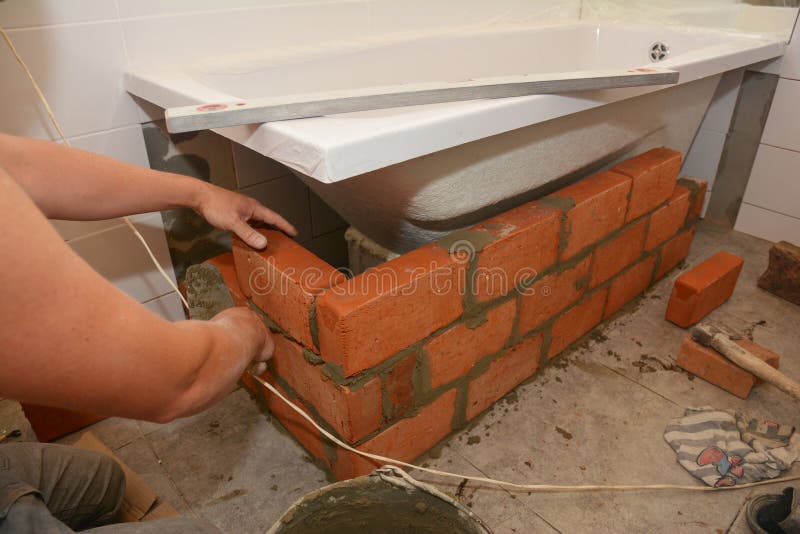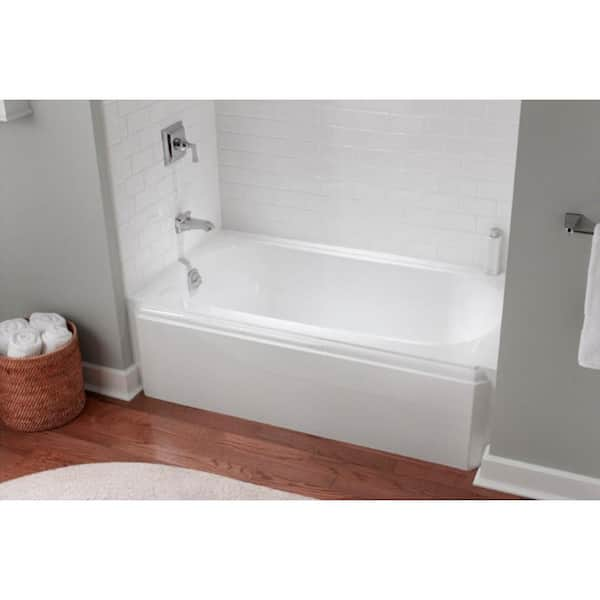Discovering Plumbing Basics is Essential When Installing a Bathtub
Discovering Plumbing Basics is Essential When Installing a Bathtub
Blog Article
Listed here in the next paragraph you will discover a good deal of very good additional info related to How to Install a Bathtub.

Mounting a tub isn't exactly rocket science, but it does require strong plumbing, carpentry, and also often, tiling skills. Changing an old bathtub with a brand-new one is also a reasonably tough project. If the old tub is readily accessible, the task can move immediately; if you have to open up a wall surface to get rid of the old bathtub and also position the new tub, the job is much harder. In either case, the task is within a home handyman's abilities, although you will require a helper to leave the old bathtub and also set in the new one. Make certain you have actually qualified on your own for the task as well as are comfortable trying it. Instead of employing a professional to take over a halfway-completed job, it is far better to take into consideration employing one before you start. Opportunities are you may require a professional plumber to make tube connections.
This article will certainly assist you install a brand-new tub in your washroom if you have already acquired a brand-new bathtub and do not need to change the plan of your previous supply of water pipelines.
Your tools and product checklist ought to comprise the following:
Removing Old Touches
If you need to replace old faucets with new ones as a part of your setup, then the first thing you must do is detach the water. After doing so, activate the taps to drain any type of water continuing to be in the system. The process of eliminating the existing faucets can be quite problematic as a result of the limited accessibility that is usually the instance.
Make use of a container wrench (crowsfoot spanner) or a faucet tool to undo the nut that attaches the supply pipelines to the faucets. Have a towel ready for the staying water that will originate from the pipelines. Once the supply pipelines have been removed, utilize the same tool to loosen up the nut that holds the taps onto the bath/basin. You will certainly require to quit the single faucets from transforming during this process. As soon as the taps have actually been gotten rid of, the holes in the bath/basin will need to be cleaned of any type of old sealing compound.
Before going on to fit the brand-new taps, compare the pipeline links on the old taps to the brand-new taps. If the old faucets are longer than the brand-new taps, then a shank adapter is needed for the brand-new faucets to fit.
Fitting New Taps
If the tails of the brand-new taps are plastic, then you will certainly need a plastic adapter to avoid damages to the string. One end of the adapter fits on the plastic tail of the faucet as well as the various other end offers a link to the current supply pipes.
If you need to fit a monobloc, then you will certainly call for decreasing couplers, which attaches the 10mm pipe of the monobloc to the common 15mm supply pipeline.
Next off, place the tap in the placing opening in the bath/basin guaranteeing that the washers remain in location in between the tap and the sink. Safeguard the faucet in place with the manufacturer provided backnut. As soon as the faucet is securely in position, the supply pipelines can be connected to the tails of the faucets. The taps can either be attached by using corrugated copper piping or with typical faucet ports. The previous type needs to be connected to the faucet ends initially, tightening just by hand. The supply pipelines can later be connected to the other end. Tighten both ends with a spanner after both ends have been connected.
Setting up the Bathtub
Utilizing the two wood boards under its feet, put the tub in the required setting. The wood boards are useful in equally spreading the weight of the bath tub over the location of the boards instead of focusing all the weight onto 4 tiny factors.
The following objective is to guarantee that the bath tub is leveled all round. This can be attained by examining the level as well as adjusting the feet on the bathtub up until the level checks out level.
To mount taps, fit the bottom of the furthest versatile tap port to the ideal supply pipe by making a compression sign up with; then do the very same for the various other tap.
Turn on the supply of water and also examine all joints as well as new pipework for leaks and tighten them if needed. Fill up the bathtub and also examine the overflow electrical outlet as well as the typical outlet for leaks.
Finally, fix the bathroom paneling as defined in the producer's instruction manual. Tiling as well as sealing around the bathtub needs to wait till the tub has actually been utilized a minimum of when as this will certainly resolve it right into its final placement.
Planning for the Setup
First of all, the sustaining frame provided with the bath ought to be fitted (if needed) according to the maker's instructions. Next off, fit the taps or mixer to the tub. When suitable the tap block, it is very important to see to it that if the tap includes a plastic washing machine, it is fitted in between the bath and the taps. On a plastic bath, it is also sensible to fit a supporting plate under the taps device to stop stress on the bath tub.
Fit the adaptable faucet ports to the bottom of both faucets making use of 2 nuts and also olives (occasionally supplied with the bathtub). Fit the plug-hole outlet by smearing mastic filler round the sink electrical outlet hole, and after that pass the outlet with the hole in the bath. Make use of the nut supplied by the maker to fit the plug-hole. Check out the plug-hole electrical outlet for an inlet on the side for the overflow pipe.
Next off, fit completion of the adaptable overflow pipeline to the overflow electrical outlet. After that, screw the pipe to the overflow face which need to be fitted inside the bathroom. Make sure you make use of all of the supplied washers.
Link the trap to the bottom of the waste electrical outlet on the tub by winding the thread of the waste outlet with silicone mastic or PTFE tape, as well as screw on the catch to the outlet. Attach all-time low of the overflow tube in a similar manner.The bathroom should currently be ready to be suited its last position.
Tiling Around the Bath tub
In the location where the bathroom satisfies the ceramic tile, it is required to seal the accompanies a silicone rubber caulking. This is important as the installation can move enough to split a stiff seal, creating the water to permeate the wall surface in between the bath as well as the tiling, causing issues with dampness and feasible leaks to the ceiling listed below.
You can select from a selection of coloured sealers to assimilate your components and also installations. They are offered in tubes and also cartridges, and are capable of securing spaces as much as a width of 3mm (1/8 inch). If you have a larger space to fill up, you can fill it with twists of soaked newspaper or soft rope. Keep in mind to constantly fill the bathtub with water before securing, to permit the movement experienced when the bathtub is in use. The sealant can break rather early if you do not take into account this motion before sealing.
Additionally, ceramic coving or quadrant tiles can be used to border the bath or shower tray. Plastic strips of coving, which are easy to use and cut to dimension, are likewise quickly available on the marketplace. It is suggested to fit the ceramic tiles making use of waterproof or water resistant sticky as well as grout.
Bathtub Installation
How Important Is A Bathtub To Your Home?
High-quality baths, showers, and other bathroom updates are necessary when considering a smart investment in your home. It’s a room that you go to every day and one that is constantly being used by guests.The bathroom is one of the top trafficked rooms in a home and also one of the most valuable in terms of home resale.
Install Piping Before Tub
You will be using your existing drain and waste vent system, but pipes required include the hot and cold water supply lines and a pipe leading to a shower head. A mixing valve and shower head are also needed. Air chambers may be required.
Position the Tub
Lower the tub into place so that the continuous flange fits against the wall studs and rests on 1’x4' or 2’x4' supports. Anchor the tub to the enclosure with nails or screws inserted through the flanges into the studs.
NOTE: Remember, bathtubs and shower stalls may require support framing. A bathtub filled with water is extremely heavy, so check building codes and framing support before installing the tub.
Assemble Drain Connections
Assemble the bathtub drain connections by connecting the tub overflow with the tub drain above the trap, not beyond it. The trap will have a compression fitting that screws over the arm of the overflow assembly.
Place a Pipe For the Shower Head
First, locate a brass female threaded winged fitting and attach it to a framing support via a screw or a nail. Then run a pipe up the wall for the shower head. Sweat or solder the other side of the brass fitting to the top of the pipe.
Attaching Hot and Cold Water Lines
Attach your water lines for both hot and cold by sweating these directly into the hot and cold ports of the mixing valve. The mixing valve will be how water enters the tub’s system, not by the pipes themselves.
Install the Spout
Extend a piece of 1/2 inch pipe, or whichever length is specified in the manufacturer’s instructions, for the tub spout. Sweat on a male threaded fitting at the end of the pipe or use a brass nipple of the proper length and a 1/2 inch cap.
NOTE: At this point you should have your rough-in plumbing work inspected before proceeding further.
Check For Leaks
Restore the water pressure and check the drain connection and the supply pipes for any sign of leaking.
estore the Bathroom Wall
Replace the wall with moisture-resistant drywall as a base for your wall covering. Seal the joints between the wall and your new tub with silicone caulk as protection against water seepage.
https://www.berkeys.com/2016/12/02/bathtub-installation-dallas/

Do you like more info about How to Install a Bathtub: Install an Acrylic Tub and Tub Surround? Post a short review down below. We would be glad to know your reactions about this blog post. We hope to see you back again in the future. If you please take the opportunity to share this article if you enjoyed reading it. Thanks a lot for taking the time to read it.
Affordable? Call now! Report this page